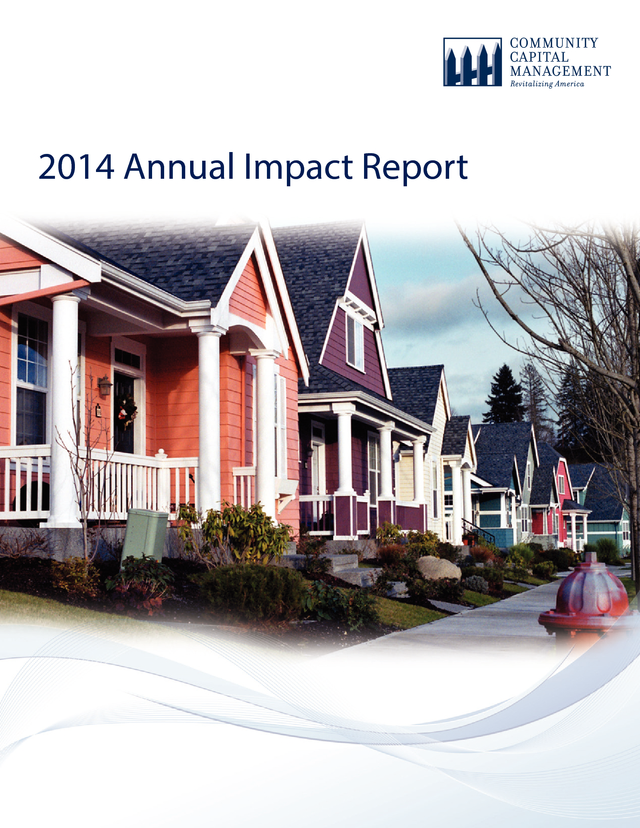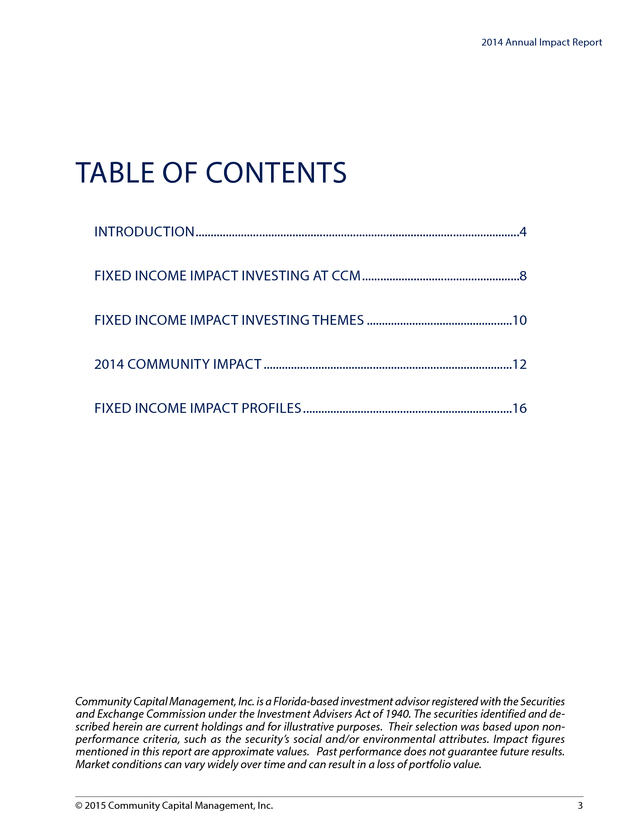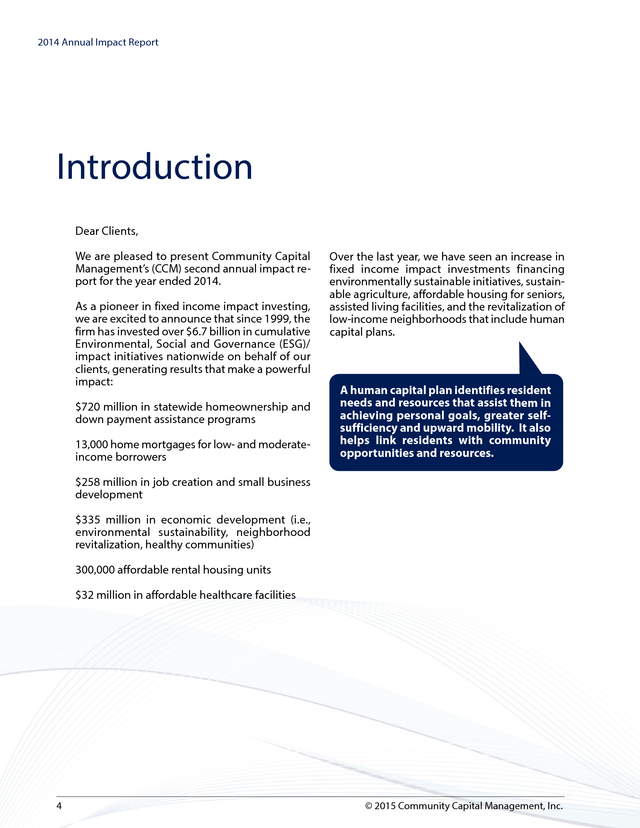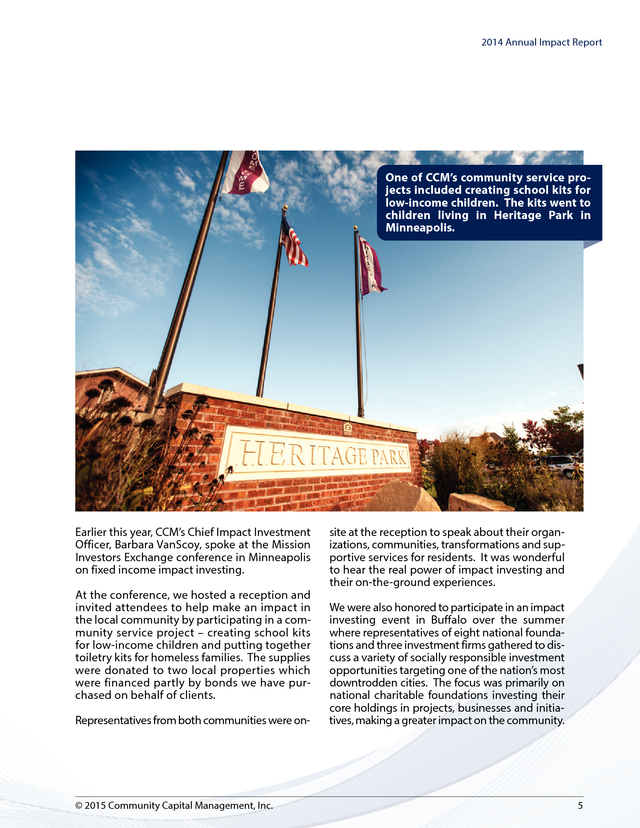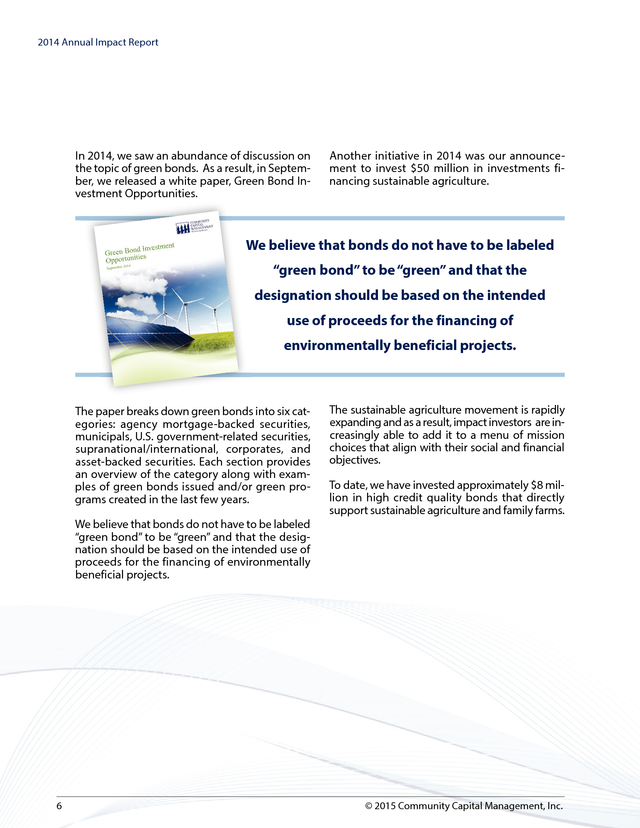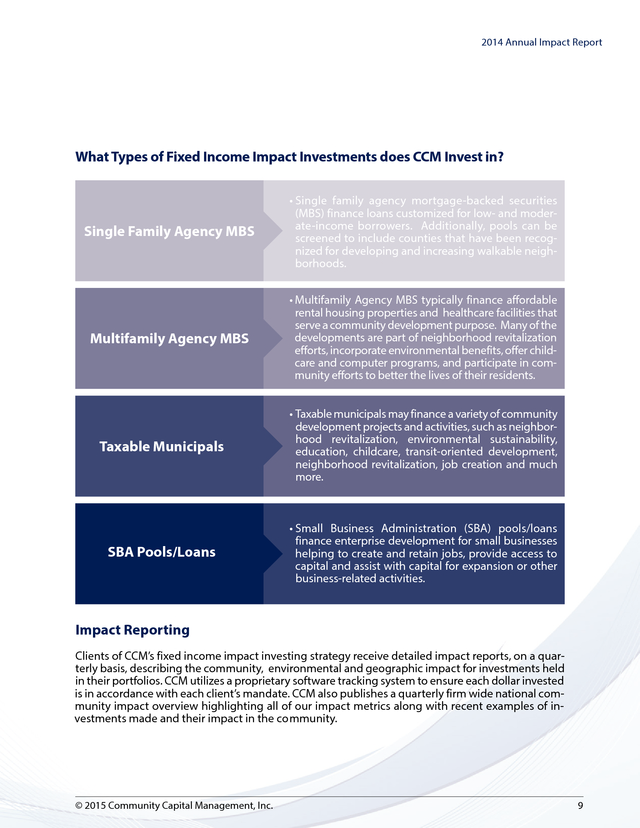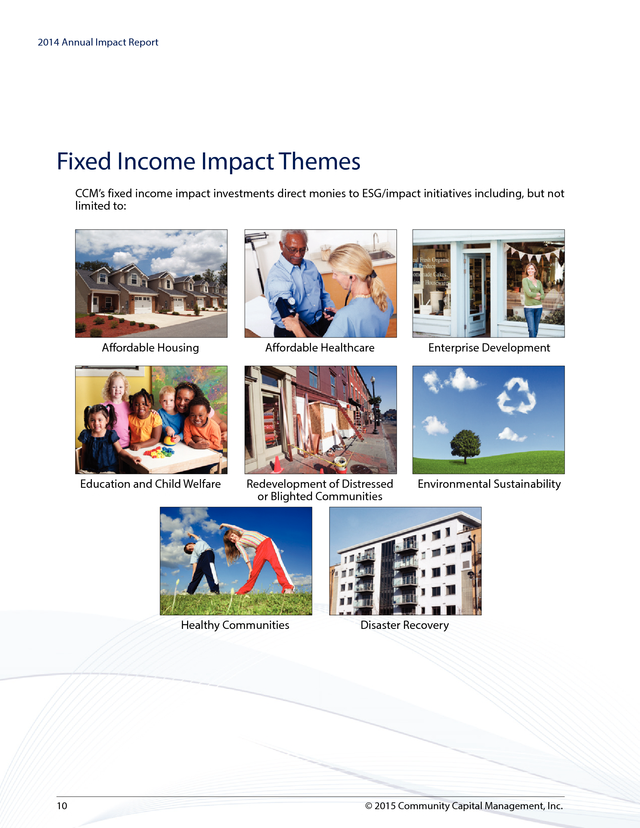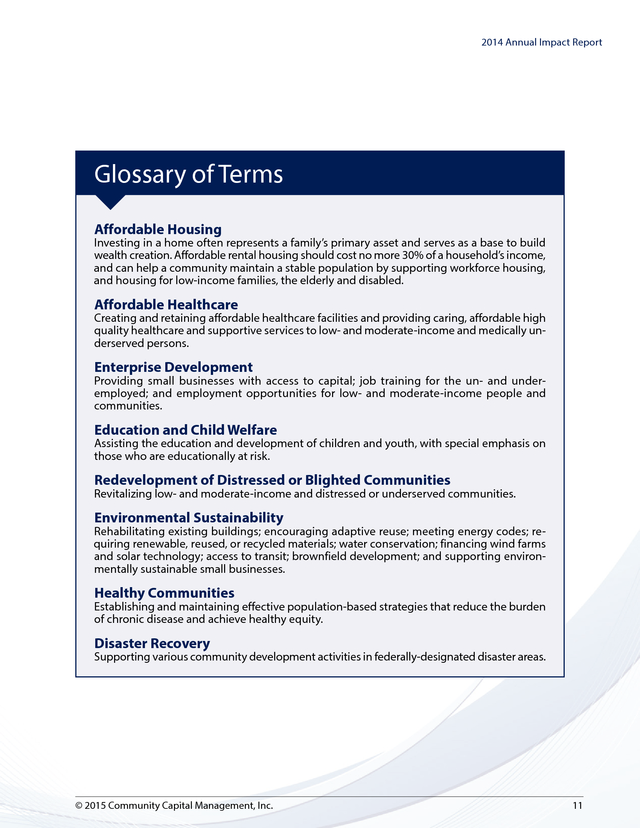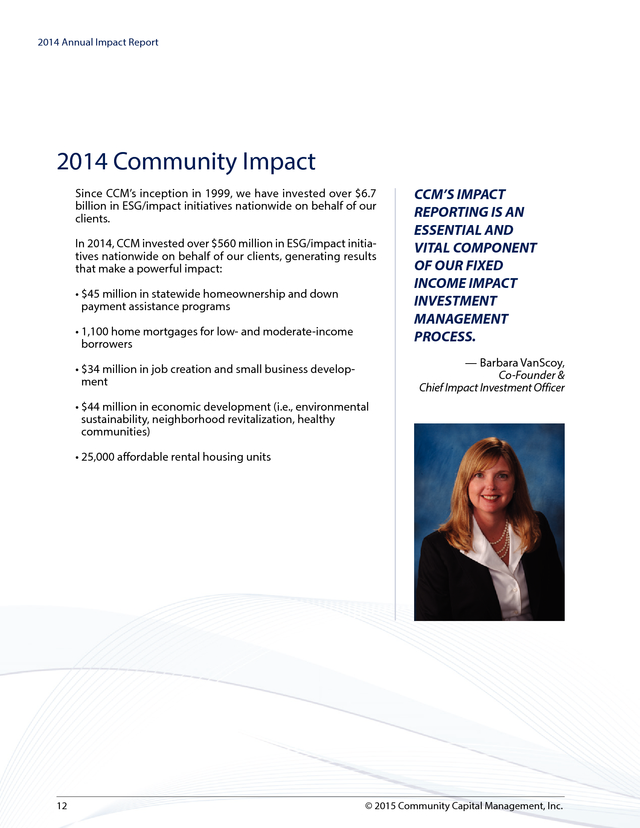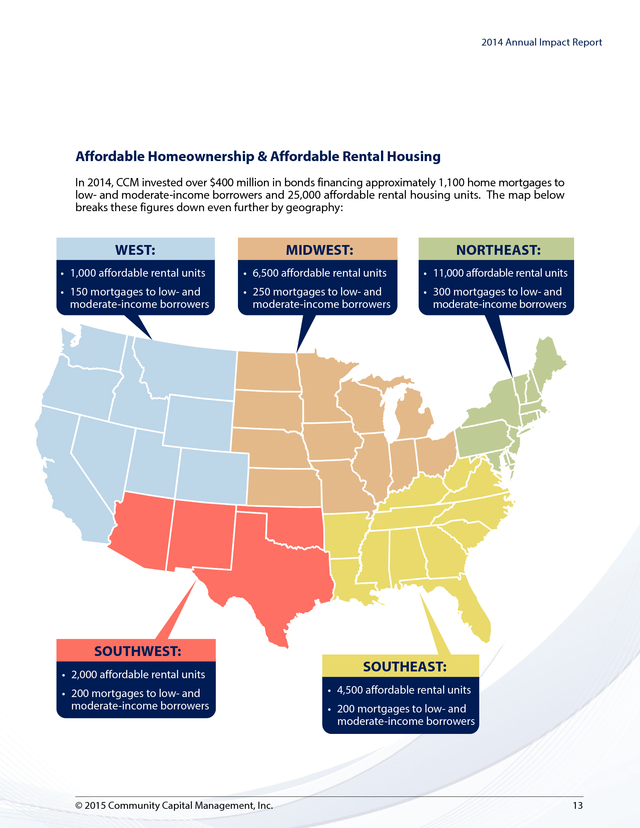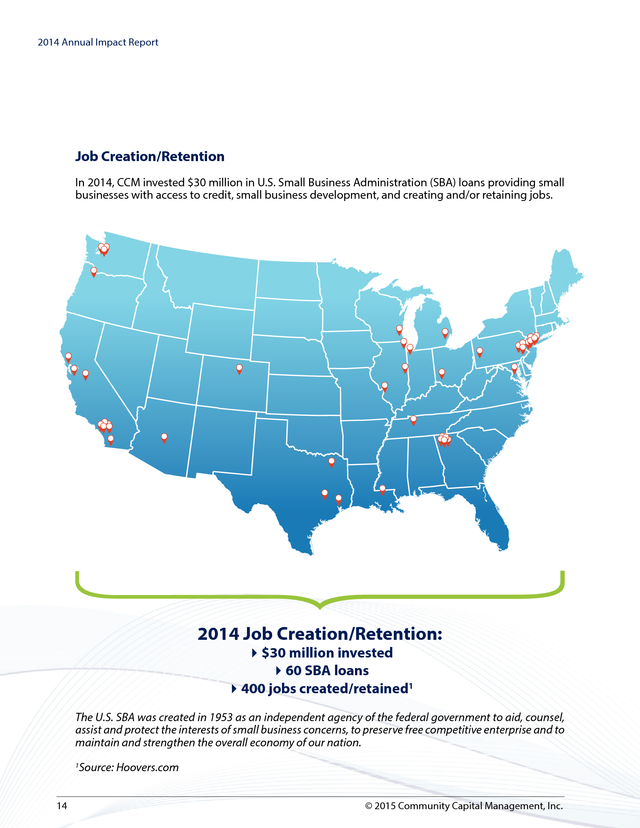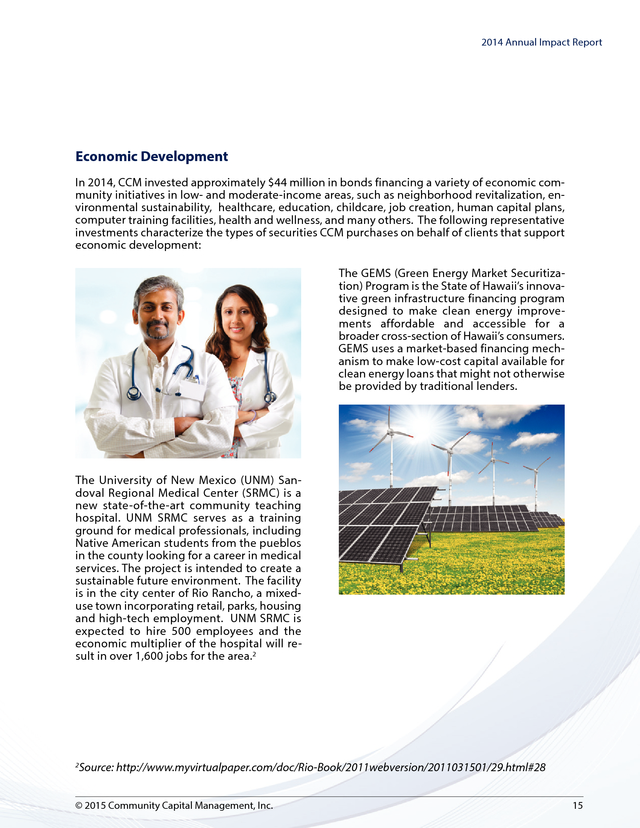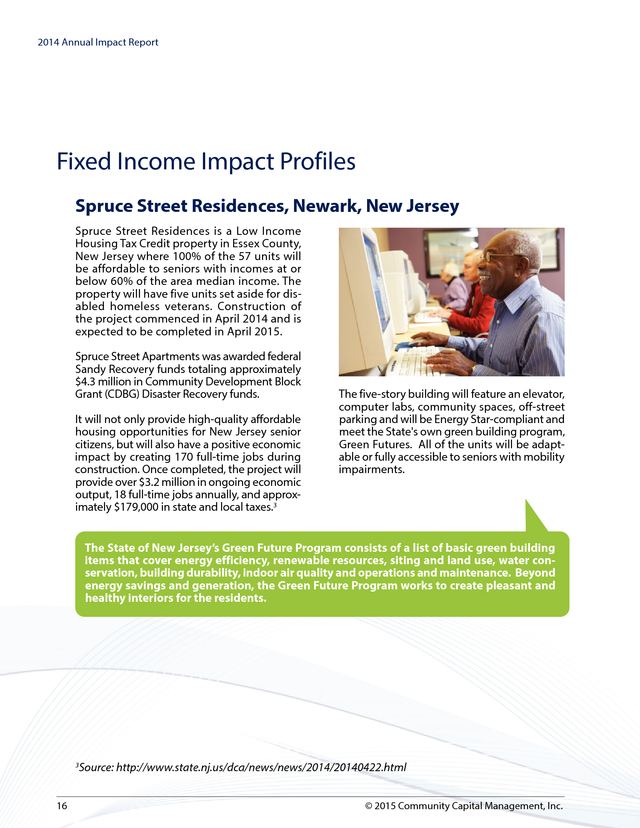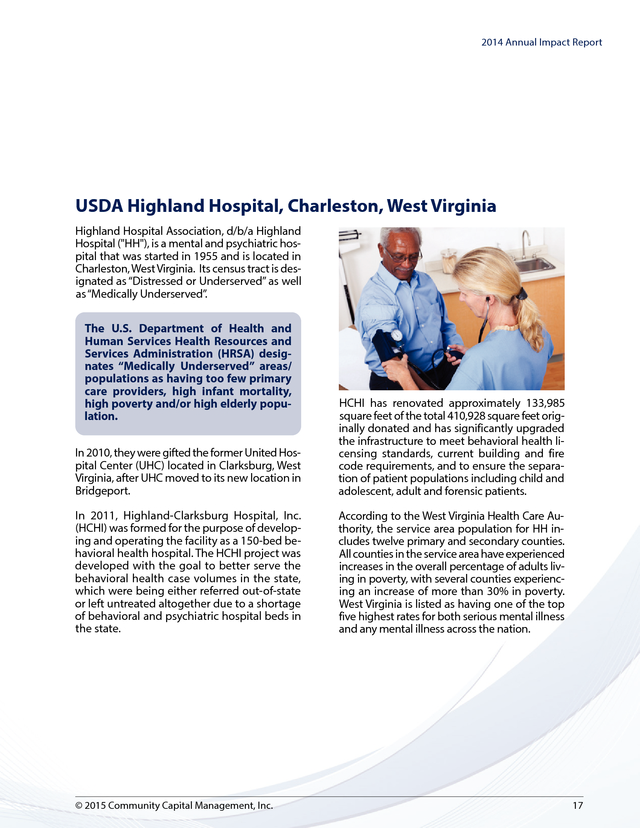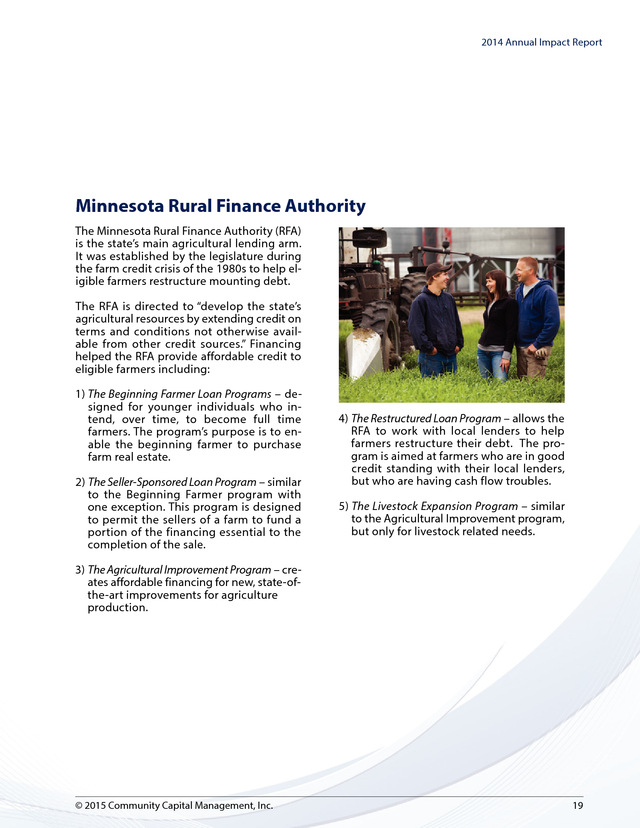Description
2014 Annual Impact Report
.
. 2014 Annual Impact Report
TABLE OF CONTENTS
INTRODUCTION...........................................................................................................4
FIXED INCOME IMPACT INVESTING AT CCM....................................................8
FIXED INCOME IMPACT INVESTING THEMES ................................................10
2014 COMMUNITY IMPACT ..................................................................................12
FIXED INCOME IMPACT PROFILES .....................................................................16
Community Capital Management, Inc. is a Florida-based investment advisor registered with the Securities
and Exchange Commission under the Investment Advisers Act of 1940. The securities identified and described herein are current holdings and for illustrative purposes. Their selection was based upon nonperformance criteria, such as the security’s social and/or environmental attributes.
Impact figures mentioned in this report are approximate values. Past performance does not guarantee future results. Market conditions can vary widely over time and can result in a loss of portfolio value. © 2015 Community Capital Management, Inc. 3 . 2014 Annual Impact Report Introduction Dear Clients, We are pleased to present Community Capital Management’s (CCM) second annual impact report for the year ended 2014. As a pioneer in fixed income impact investing, we are excited to announce that since 1999, the firm has invested over $6.7 billion in cumulative Environmental, Social and Governance (ESG)/ impact initiatives nationwide on behalf of our clients, generating results that make a powerful impact: $720 million in statewide homeownership and down payment assistance programs 13,000 home mortgages for low- and moderateincome borrowers Over the last year, we have seen an increase in fixed income impact investments financing environmentally sustainable initiatives, sustainable agriculture, affordable housing for seniors, assisted living facilities, and the revitalization of low-income neighborhoods that include human capital plans. A human capital plan identifies resident needs and resources that assist them in achieving personal goals, greater selfsufficiency and upward mobility. It also helps link residents with community opportunities and resources. $258 million in job creation and small business development $335 million in economic development (i.e., environmental sustainability, neighborhood revitalization, healthy communities) 300,000 affordable rental housing units $32 million in affordable healthcare facilities 4 © 2015 Community Capital Management, Inc. . 2014 Annual Impact Report One of CCM’s community service projects included creating school kits for low-income children. The kits went to children living in Heritage Park in Minneapolis. Earlier this year, CCM’s Chief Impact Investment Officer, Barbara VanScoy, spoke at the Mission Investors Exchange conference in Minneapolis on fixed income impact investing. At the conference, we hosted a reception and invited attendees to help make an impact in the local community by participating in a community service project – creating school kits for low-income children and putting together toiletry kits for homeless families. The supplies were donated to two local properties which were financed partly by bonds we have purchased on behalf of clients. Representatives from both communities were on- © 2015 Community Capital Management, Inc. site at the reception to speak about their organizations, communities, transformations and supportive services for residents. It was wonderful to hear the real power of impact investing and their on-the-ground experiences. We were also honored to participate in an impact investing event in Buffalo over the summer where representatives of eight national foundations and three investment firms gathered to discuss a variety of socially responsible investment opportunities targeting one of the nation’s most downtrodden cities.
The focus was primarily on national charitable foundations investing their core holdings in projects, businesses and initiatives, making a greater impact on the community. 5 . 2014 Annual Impact Report In 2014, we saw an abundance of discussion on the topic of green bonds. As a result, in September, we released a white paper, Green Bond Investment Opportunities. Another initiative in 2014 was our announcement to invest $50 million in investments financing sustainable agriculture. We believe that bonds do not have to be labeled “green bond” to be “green” and that the designation should be based on the intended use of proceeds for the financing of environmentally beneficial projects. The paper breaks down green bonds into six categories: agency mortgage-backed securities, municipals, U.S. government-related securities, supranational/international, corporates, and asset-backed securities. Each section provides an overview of the category along with examples of green bonds issued and/or green programs created in the last few years. The sustainable agriculture movement is rapidly expanding and as a result, impact investors are increasingly able to add it to a menu of mission choices that align with their social and financial objectives. To date, we have invested approximately $8 million in high credit quality bonds that directly support sustainable agriculture and family farms. We believe that bonds do not have to be labeled “green bond” to be “green” and that the designation should be based on the intended use of proceeds for the financing of environmentally beneficial projects. 6 © 2015 Community Capital Management, Inc. .
2014 Annual Impact Report Lastly, for the past two years, we have been an active participant in the Community Investing Working Group of The Clinton Global Initiative America (CGI America), a program of The Clinton Global Initiative, which addresses economic recovery in the United States. Some initiatives currently underway include: In connection with this effort, the firm made a CGI America Commitment to Action to invest at least $200 million in market-rate, fixed income securities helping to revitalize U.S. local communities. We have already surpassed this goal and are working with CDFIs and other community development intermediaries participating in the CGI America community to further our impact. • Exploring ways to invest in small business loans originated by Community Development Financial Institutions (CDFIs). • Working with FairMortgage.com, a new internet based mortgage market platform that will provide affordable home mortgages to lowand moderate income homebuyers; and We are excited about the many opportunities currently available in the fixed income ESG/impact investing space and look forward to continuing our 15 plus years of work in the field. Sincerely, Community Capital Management, Inc. © 2015 Community Capital Management, Inc. 7 . 2014 Annual Impact Report Fixed Income Impact Investing at CCM A primary component of CCM’s fixed income impact investing strategy is its pioneering research method, which combines impact research with financial analysis. We believe this approach provides an added layer of investment transparency by detailing the use of bond proceeds and providing a full understanding of the programs being financed. Integrated Two-Prong Approach Integrated two-prong approach • Designed for institutions and individual investors looking for a market-rate fixed income product whose proceeds are designed to positively impact communities nationwide. First Prong: Financial • CCM’s fixed income impact investing strategy seeks to provide a high level of current income consistent with the preservation of capital. Second Prong: Impact 8 • Clients have the opportunity for their investments to support specific impact themes or geographies. © 2015 Community Capital Management, Inc. . 2014 Annual Impact Report What Types of Fixed Income Impact Investments does CCM Invest in? Single Family Agency MBS • Single family agency mortgage-backed securities (MBS) finance loans customized for low- and moderate-income borrowers. Additionally, pools can be screened to include counties that have been recognized for developing and increasing walkable neighborhoods. Multifamily Agency MBS • Multifamily Agency MBS typically finance affordable rental housing properties and healthcare facilities that serve a community development purpose. Many of the developments are part of neighborhood revitalization efforts, incorporate environmental benefits, offer childcare and computer programs, and participate in community efforts to better the lives of their residents. Taxable Municipals • Taxable municipals may finance a variety of community development projects and activities, such as neighborhood revitalization, environmental sustainability, education, childcare, transit-oriented development, neighborhood revitalization, job creation and much more. SBA Pools/Loans • Small Business Administration (SBA) pools/loans finance enterprise development for small businesses helping to create and retain jobs, provide access to capital and assist with capital for expansion or other business-related activities. Impact Reporting Clients of CCM’s fixed income impact investing strategy receive detailed impact reports, on a quarterly basis, describing the community, environmental and geographic impact for investments held in their portfolios. CCM utilizes a proprietary software tracking system to ensure each dollar invested is in accordance with each client’s mandate.
CCM also publishes a quarterly firm wide national community impact overview highlighting all of our impact metrics along with recent examples of investments made and their impact in the community. © 2015 Community Capital Management, Inc. 9 . 2014 Annual Impact Report Fixed Income Impact Themes CCM’s fixed income impact investments direct monies to ESG/impact initiatives including, but not limited to: Affordable Housing Affordable Healthcare Enterprise Development Education and Child Welfare Redevelopment of Distressed or Blighted Communities Environmental Sustainability Healthy Communities 10 Disaster Recovery © 2015 Community Capital Management, Inc. . 2014 Annual Impact Report Glossary of Terms Affordable Housing Investing in a home often represents a family’s primary asset and serves as a base to build wealth creation. Affordable rental housing should cost no more 30% of a household’s income, and can help a community maintain a stable population by supporting workforce housing, and housing for low-income families, the elderly and disabled. Affordable Healthcare Creating and retaining affordable healthcare facilities and providing caring, affordable high quality healthcare and supportive services to low- and moderate-income and medically underserved persons. Enterprise Development Providing small businesses with access to capital; job training for the un- and underemployed; and employment opportunities for low- and moderate-income people and communities. Education and Child Welfare Assisting the education and development of children and youth, with special emphasis on those who are educationally at risk. Redevelopment of Distressed or Blighted Communities Revitalizing low- and moderate-income and distressed or underserved communities. Environmental Sustainability Rehabilitating existing buildings; encouraging adaptive reuse; meeting energy codes; requiring renewable, reused, or recycled materials; water conservation; financing wind farms and solar technology; access to transit; brownfield development; and supporting environmentally sustainable small businesses. Healthy Communities Establishing and maintaining effective population-based strategies that reduce the burden of chronic disease and achieve healthy equity. Disaster Recovery Supporting various community development activities in federally-designated disaster areas. © 2015 Community Capital Management, Inc. 11 . 2014 Annual Impact Report 2014 Community Impact Since CCM’s inception in 1999, we have invested over $6.7 billion in ESG/impact initiatives nationwide on behalf of our clients. In 2014, CCM invested over $560 million in ESG/impact initiatives nationwide on behalf of our clients, generating results that make a powerful impact: • $45 million in statewide homeownership and down payment assistance programs • 1,100 home mortgages for low- and moderate-income borrowers CCM’S IMPACT REPORTING IS AN ESSENTIAL AND VITAL COMPONENT OF OUR FIXED INCOME IMPACT INVESTMENT MANAGEMENT PROCESS. — Barbara VanScoy, Co-Founder & Chief Impact Investment Officer • $34 million in job creation and small business development • $44 million in economic development (i.e., environmental sustainability, neighborhood revitalization, healthy communities) • 25,000 affordable rental housing units 12 © 2015 Community Capital Management, Inc. . 2014 Annual Impact Report Affordable Homeownership & Affordable Rental Housing In 2014, CCM invested over $400 million in bonds financing approximately 1,100 home mortgages to low- and moderate-income borrowers and 25,000 affordable rental housing units. The map below breaks these figures down even further by geography: WEST: MIDWEST: NORTHEAST: • 1,000 affordable rental units • 6,500 affordable rental units • 11,000 affordable rental units • 150 mortgages to low- and moderate-income borrowers • 250 mortgages to low- and moderate-income borrowers • 300 mortgages to low- and moderate-income borrowers SOUTHWEST: • 2,000 affordable rental units • 200 mortgages to low- and moderate-income borrowers © 2015 Community Capital Management, Inc. SOUTHEAST: • 4,500 affordable rental units • 200 mortgages to low- and moderate-income borrowers 13 . 2014 Annual Impact Report Job Creation/Retention In 2014, CCM invested $30 million in U.S. Small Business Administration (SBA) loans providing small businesses with access to credit, small business development, and creating and/or retaining jobs. 2014 Job Creation/Retention: 4$30 million invested 460 SBA loans 4400 jobs created/retained1 The U.S. SBA was created in 1953 as an independent agency of the federal government to aid, counsel, assist and protect the interests of small business concerns, to preserve free competitive enterprise and to maintain and strengthen the overall economy of our nation. 1 Source: Hoovers.com 14 © 2015 Community Capital Management, Inc. . 2014 Annual Impact Report Economic Development In 2014, CCM invested approximately $44 million in bonds financing a variety of economic community initiatives in low- and moderate-income areas, such as neighborhood revitalization, environmental sustainability, healthcare, education, childcare, job creation, human capital plans, computer training facilities, health and wellness, and many others. The following representative investments characterize the types of securities CCM purchases on behalf of clients that support economic development: The GEMS (Green Energy Market Securitization) Program is the State of Hawaii’s innovative green infrastructure financing program designed to make clean energy improvements affordable and accessible for a broader cross-section of Hawaii’s consumers. GEMS uses a market-based financing mechanism to make low-cost capital available for clean energy loans that might not otherwise be provided by traditional lenders. The University of New Mexico (UNM) Sandoval Regional Medical Center (SRMC) is a new state-of-the-art community teaching hospital. UNM SRMC serves as a training ground for medical professionals, including Native American students from the pueblos in the county looking for a career in medical services. The project is intended to create a sustainable future environment.
The facility is in the city center of Rio Rancho, a mixeduse town incorporating retail, parks, housing and high-tech employment. UNM SRMC is expected to hire 500 employees and the economic multiplier of the hospital will result in over 1,600 jobs for the area.2 2 Source: http://www.myvirtualpaper.com/doc/Rio-Book/2011webversion/2011031501/29.html#28 © 2015 Community Capital Management, Inc. 15 . 2014 Annual Impact Report Fixed Income Impact Profiles Spruce Street Residences, Newark, New Jersey Spruce Street Residences is a Low Income Housing Tax Credit property in Essex County, New Jersey where 100% of the 57 units will be affordable to seniors with incomes at or below 60% of the area median income. The property will have five units set aside for disabled homeless veterans. Construction of the project commenced in April 2014 and is expected to be completed in April 2015. Spruce Street Apartments was awarded federal Sandy Recovery funds totaling approximately $4.3 million in Community Development Block Grant (CDBG) Disaster Recovery funds. It will not only provide high-quality affordable housing opportunities for New Jersey senior citizens, but will also have a positive economic impact by creating 170 full-time jobs during construction. Once completed, the project will provide over $3.2 million in ongoing economic output, 18 full-time jobs annually, and approximately $179,000 in state and local taxes.3 The five-story building will feature an elevator, computer labs, community spaces, off-street parking and will be Energy Star-compliant and meet the State's own green building program, Green Futures.
All of the units will be adaptable or fully accessible to seniors with mobility impairments. The State of New Jersey’s Green Future Program consists of a list of basic green building items that cover energy efficiency, renewable resources, siting and land use, water conservation, building durability, indoor air quality and operations and maintenance. Beyond energy savings and generation, the Green Future Program works to create pleasant and healthy interiors for the residents. 3 Source: http://www.state.nj.us/dca/news/news/2014/20140422.html 16 © 2015 Community Capital Management, Inc. . 2014 Annual Impact Report USDA Highland Hospital, Charleston, West Virginia Highland Hospital Association, d/b/a Highland Hospital ("HH"), is a mental and psychiatric hospital that was started in 1955 and is located in Charleston, West Virginia. Its census tract is designated as “Distressed or Underserved” as well as “Medically Underserved”. The U.S. Department of Health and Human Services Health Resources and Services Administration (HRSA) designates “Medically Underserved” areas/ populations as having too few primary care providers, high infant mortality, high poverty and/or high elderly population. In 2010, they were gifted the former United Hospital Center (UHC) located in Clarksburg, West Virginia, after UHC moved to its new location in Bridgeport. HCHI has renovated approximately 133,985 square feet of the total 410,928 square feet originally donated and has significantly upgraded the infrastructure to meet behavioral health licensing standards, current building and fire code requirements, and to ensure the separation of patient populations including child and adolescent, adult and forensic patients. In 2011, Highland-Clarksburg Hospital, Inc. (HCHI) was formed for the purpose of developing and operating the facility as a 150-bed behavioral health hospital. The HCHI project was developed with the goal to better serve the behavioral health case volumes in the state, which were being either referred out-of-state or left untreated altogether due to a shortage of behavioral and psychiatric hospital beds in the state. According to the West Virginia Health Care Authority, the service area population for HH includes twelve primary and secondary counties. All counties in the service area have experienced increases in the overall percentage of adults living in poverty, with several counties experiencing an increase of more than 30% in poverty. West Virginia is listed as having one of the top five highest rates for both serious mental illness and any mental illness across the nation. © 2015 Community Capital Management, Inc. 17 .
2014 Annual Impact Report Tippecanoe Valley High School, Akron, Indiana The project consists of one 322-foot high, 3blade PowerWind turbine installed on the west side of the school property. The revenue being generated benefits the school’s budget by offsetting approximately 70% of current electric costs for the school.4 Tippecanoe Valley High School is located in Akron, Indiana. Financing helped construct a wind generating facility to produce electricity for the middle and high school campuses. Tippecanoe Valley is the first school corporation in Indiana to install a wind turbine with “behind-the-meter” technology allowing the school to generate approximately 70% of all electrical power used on the high school and middle school campuses. To make the project possible, Tippecanoe Valley School Corporation was awarded $2.3 million in Clean Renewable Energy Bonds. The electricity generated by the wind turbine eliminates most of the school’s electric bill for the next 25-30 years (the projected life of the wind turbine), enabling Tippecanoe Valley to redirect more dollars into the classroom now and for generations to come. Under Indiana law, energy costs are paid from the same fund as instructional costs such as teacher salaries. The wind energy project provides a renewable energy learning experience for the students which includes an integrated curriculum and enables them to model environmental stewardship and sustainable practices in their community. Clean Renewable Energy Bonds (CREBs) are a type of tax credit bond that were created under the Energy Tax Incentives Act of 2005.
CREBs are used by certain entities – primarily in the public sector – to finance renewable energy projects. CREBs expired in 2010. 4 Source: http://finance.yahoo.com/news/Tippecanoe-Valley-School-iw-163324893.html 18 © 2015 Community Capital Management, Inc. . 2014 Annual Impact Report Minnesota Rural Finance Authority The Minnesota Rural Finance Authority (RFA) is the state’s main agricultural lending arm. It was established by the legislature during the farm credit crisis of the 1980s to help eligible farmers restructure mounting debt. The RFA is directed to “develop the state’s agricultural resources by extending credit on terms and conditions not otherwise available from other credit sources.” Financing helped the RFA provide affordable credit to eligible farmers including: 1) The Beginning Farmer Loan Programs – designed for younger individuals who intend, over time, to become full time farmers. The program’s purpose is to enable the beginning farmer to purchase farm real estate. 2) The Seller-Sponsored Loan Program – similar to the Beginning Farmer program with one exception. This program is designed to permit the sellers of a farm to fund a portion of the financing essential to the completion of the sale. 4) The Restructured Loan Program – allows the RFA to work with local lenders to help farmers restructure their debt. The program is aimed at farmers who are in good credit standing with their local lenders, but who are having cash flow troubles. 5) The Livestock Expansion Program – similar to the Agricultural Improvement program, but only for livestock related needs. 3) The Agricultural Improvement Program – creates affordable financing for new, state-ofthe-art improvements for agriculture production. © 2015 Community Capital Management, Inc. 19 .
2500 Weston Road, Suite 101 • Weston, Florida 33331 phone 954.217.7999 • fax 954.385.9299 www.ccmfixedincome.com .
Impact figures mentioned in this report are approximate values. Past performance does not guarantee future results. Market conditions can vary widely over time and can result in a loss of portfolio value. © 2015 Community Capital Management, Inc. 3 . 2014 Annual Impact Report Introduction Dear Clients, We are pleased to present Community Capital Management’s (CCM) second annual impact report for the year ended 2014. As a pioneer in fixed income impact investing, we are excited to announce that since 1999, the firm has invested over $6.7 billion in cumulative Environmental, Social and Governance (ESG)/ impact initiatives nationwide on behalf of our clients, generating results that make a powerful impact: $720 million in statewide homeownership and down payment assistance programs 13,000 home mortgages for low- and moderateincome borrowers Over the last year, we have seen an increase in fixed income impact investments financing environmentally sustainable initiatives, sustainable agriculture, affordable housing for seniors, assisted living facilities, and the revitalization of low-income neighborhoods that include human capital plans. A human capital plan identifies resident needs and resources that assist them in achieving personal goals, greater selfsufficiency and upward mobility. It also helps link residents with community opportunities and resources. $258 million in job creation and small business development $335 million in economic development (i.e., environmental sustainability, neighborhood revitalization, healthy communities) 300,000 affordable rental housing units $32 million in affordable healthcare facilities 4 © 2015 Community Capital Management, Inc. . 2014 Annual Impact Report One of CCM’s community service projects included creating school kits for low-income children. The kits went to children living in Heritage Park in Minneapolis. Earlier this year, CCM’s Chief Impact Investment Officer, Barbara VanScoy, spoke at the Mission Investors Exchange conference in Minneapolis on fixed income impact investing. At the conference, we hosted a reception and invited attendees to help make an impact in the local community by participating in a community service project – creating school kits for low-income children and putting together toiletry kits for homeless families. The supplies were donated to two local properties which were financed partly by bonds we have purchased on behalf of clients. Representatives from both communities were on- © 2015 Community Capital Management, Inc. site at the reception to speak about their organizations, communities, transformations and supportive services for residents. It was wonderful to hear the real power of impact investing and their on-the-ground experiences. We were also honored to participate in an impact investing event in Buffalo over the summer where representatives of eight national foundations and three investment firms gathered to discuss a variety of socially responsible investment opportunities targeting one of the nation’s most downtrodden cities.
The focus was primarily on national charitable foundations investing their core holdings in projects, businesses and initiatives, making a greater impact on the community. 5 . 2014 Annual Impact Report In 2014, we saw an abundance of discussion on the topic of green bonds. As a result, in September, we released a white paper, Green Bond Investment Opportunities. Another initiative in 2014 was our announcement to invest $50 million in investments financing sustainable agriculture. We believe that bonds do not have to be labeled “green bond” to be “green” and that the designation should be based on the intended use of proceeds for the financing of environmentally beneficial projects. The paper breaks down green bonds into six categories: agency mortgage-backed securities, municipals, U.S. government-related securities, supranational/international, corporates, and asset-backed securities. Each section provides an overview of the category along with examples of green bonds issued and/or green programs created in the last few years. The sustainable agriculture movement is rapidly expanding and as a result, impact investors are increasingly able to add it to a menu of mission choices that align with their social and financial objectives. To date, we have invested approximately $8 million in high credit quality bonds that directly support sustainable agriculture and family farms. We believe that bonds do not have to be labeled “green bond” to be “green” and that the designation should be based on the intended use of proceeds for the financing of environmentally beneficial projects. 6 © 2015 Community Capital Management, Inc. .
2014 Annual Impact Report Lastly, for the past two years, we have been an active participant in the Community Investing Working Group of The Clinton Global Initiative America (CGI America), a program of The Clinton Global Initiative, which addresses economic recovery in the United States. Some initiatives currently underway include: In connection with this effort, the firm made a CGI America Commitment to Action to invest at least $200 million in market-rate, fixed income securities helping to revitalize U.S. local communities. We have already surpassed this goal and are working with CDFIs and other community development intermediaries participating in the CGI America community to further our impact. • Exploring ways to invest in small business loans originated by Community Development Financial Institutions (CDFIs). • Working with FairMortgage.com, a new internet based mortgage market platform that will provide affordable home mortgages to lowand moderate income homebuyers; and We are excited about the many opportunities currently available in the fixed income ESG/impact investing space and look forward to continuing our 15 plus years of work in the field. Sincerely, Community Capital Management, Inc. © 2015 Community Capital Management, Inc. 7 . 2014 Annual Impact Report Fixed Income Impact Investing at CCM A primary component of CCM’s fixed income impact investing strategy is its pioneering research method, which combines impact research with financial analysis. We believe this approach provides an added layer of investment transparency by detailing the use of bond proceeds and providing a full understanding of the programs being financed. Integrated Two-Prong Approach Integrated two-prong approach • Designed for institutions and individual investors looking for a market-rate fixed income product whose proceeds are designed to positively impact communities nationwide. First Prong: Financial • CCM’s fixed income impact investing strategy seeks to provide a high level of current income consistent with the preservation of capital. Second Prong: Impact 8 • Clients have the opportunity for their investments to support specific impact themes or geographies. © 2015 Community Capital Management, Inc. . 2014 Annual Impact Report What Types of Fixed Income Impact Investments does CCM Invest in? Single Family Agency MBS • Single family agency mortgage-backed securities (MBS) finance loans customized for low- and moderate-income borrowers. Additionally, pools can be screened to include counties that have been recognized for developing and increasing walkable neighborhoods. Multifamily Agency MBS • Multifamily Agency MBS typically finance affordable rental housing properties and healthcare facilities that serve a community development purpose. Many of the developments are part of neighborhood revitalization efforts, incorporate environmental benefits, offer childcare and computer programs, and participate in community efforts to better the lives of their residents. Taxable Municipals • Taxable municipals may finance a variety of community development projects and activities, such as neighborhood revitalization, environmental sustainability, education, childcare, transit-oriented development, neighborhood revitalization, job creation and much more. SBA Pools/Loans • Small Business Administration (SBA) pools/loans finance enterprise development for small businesses helping to create and retain jobs, provide access to capital and assist with capital for expansion or other business-related activities. Impact Reporting Clients of CCM’s fixed income impact investing strategy receive detailed impact reports, on a quarterly basis, describing the community, environmental and geographic impact for investments held in their portfolios. CCM utilizes a proprietary software tracking system to ensure each dollar invested is in accordance with each client’s mandate.
CCM also publishes a quarterly firm wide national community impact overview highlighting all of our impact metrics along with recent examples of investments made and their impact in the community. © 2015 Community Capital Management, Inc. 9 . 2014 Annual Impact Report Fixed Income Impact Themes CCM’s fixed income impact investments direct monies to ESG/impact initiatives including, but not limited to: Affordable Housing Affordable Healthcare Enterprise Development Education and Child Welfare Redevelopment of Distressed or Blighted Communities Environmental Sustainability Healthy Communities 10 Disaster Recovery © 2015 Community Capital Management, Inc. . 2014 Annual Impact Report Glossary of Terms Affordable Housing Investing in a home often represents a family’s primary asset and serves as a base to build wealth creation. Affordable rental housing should cost no more 30% of a household’s income, and can help a community maintain a stable population by supporting workforce housing, and housing for low-income families, the elderly and disabled. Affordable Healthcare Creating and retaining affordable healthcare facilities and providing caring, affordable high quality healthcare and supportive services to low- and moderate-income and medically underserved persons. Enterprise Development Providing small businesses with access to capital; job training for the un- and underemployed; and employment opportunities for low- and moderate-income people and communities. Education and Child Welfare Assisting the education and development of children and youth, with special emphasis on those who are educationally at risk. Redevelopment of Distressed or Blighted Communities Revitalizing low- and moderate-income and distressed or underserved communities. Environmental Sustainability Rehabilitating existing buildings; encouraging adaptive reuse; meeting energy codes; requiring renewable, reused, or recycled materials; water conservation; financing wind farms and solar technology; access to transit; brownfield development; and supporting environmentally sustainable small businesses. Healthy Communities Establishing and maintaining effective population-based strategies that reduce the burden of chronic disease and achieve healthy equity. Disaster Recovery Supporting various community development activities in federally-designated disaster areas. © 2015 Community Capital Management, Inc. 11 . 2014 Annual Impact Report 2014 Community Impact Since CCM’s inception in 1999, we have invested over $6.7 billion in ESG/impact initiatives nationwide on behalf of our clients. In 2014, CCM invested over $560 million in ESG/impact initiatives nationwide on behalf of our clients, generating results that make a powerful impact: • $45 million in statewide homeownership and down payment assistance programs • 1,100 home mortgages for low- and moderate-income borrowers CCM’S IMPACT REPORTING IS AN ESSENTIAL AND VITAL COMPONENT OF OUR FIXED INCOME IMPACT INVESTMENT MANAGEMENT PROCESS. — Barbara VanScoy, Co-Founder & Chief Impact Investment Officer • $34 million in job creation and small business development • $44 million in economic development (i.e., environmental sustainability, neighborhood revitalization, healthy communities) • 25,000 affordable rental housing units 12 © 2015 Community Capital Management, Inc. . 2014 Annual Impact Report Affordable Homeownership & Affordable Rental Housing In 2014, CCM invested over $400 million in bonds financing approximately 1,100 home mortgages to low- and moderate-income borrowers and 25,000 affordable rental housing units. The map below breaks these figures down even further by geography: WEST: MIDWEST: NORTHEAST: • 1,000 affordable rental units • 6,500 affordable rental units • 11,000 affordable rental units • 150 mortgages to low- and moderate-income borrowers • 250 mortgages to low- and moderate-income borrowers • 300 mortgages to low- and moderate-income borrowers SOUTHWEST: • 2,000 affordable rental units • 200 mortgages to low- and moderate-income borrowers © 2015 Community Capital Management, Inc. SOUTHEAST: • 4,500 affordable rental units • 200 mortgages to low- and moderate-income borrowers 13 . 2014 Annual Impact Report Job Creation/Retention In 2014, CCM invested $30 million in U.S. Small Business Administration (SBA) loans providing small businesses with access to credit, small business development, and creating and/or retaining jobs. 2014 Job Creation/Retention: 4$30 million invested 460 SBA loans 4400 jobs created/retained1 The U.S. SBA was created in 1953 as an independent agency of the federal government to aid, counsel, assist and protect the interests of small business concerns, to preserve free competitive enterprise and to maintain and strengthen the overall economy of our nation. 1 Source: Hoovers.com 14 © 2015 Community Capital Management, Inc. . 2014 Annual Impact Report Economic Development In 2014, CCM invested approximately $44 million in bonds financing a variety of economic community initiatives in low- and moderate-income areas, such as neighborhood revitalization, environmental sustainability, healthcare, education, childcare, job creation, human capital plans, computer training facilities, health and wellness, and many others. The following representative investments characterize the types of securities CCM purchases on behalf of clients that support economic development: The GEMS (Green Energy Market Securitization) Program is the State of Hawaii’s innovative green infrastructure financing program designed to make clean energy improvements affordable and accessible for a broader cross-section of Hawaii’s consumers. GEMS uses a market-based financing mechanism to make low-cost capital available for clean energy loans that might not otherwise be provided by traditional lenders. The University of New Mexico (UNM) Sandoval Regional Medical Center (SRMC) is a new state-of-the-art community teaching hospital. UNM SRMC serves as a training ground for medical professionals, including Native American students from the pueblos in the county looking for a career in medical services. The project is intended to create a sustainable future environment.
The facility is in the city center of Rio Rancho, a mixeduse town incorporating retail, parks, housing and high-tech employment. UNM SRMC is expected to hire 500 employees and the economic multiplier of the hospital will result in over 1,600 jobs for the area.2 2 Source: http://www.myvirtualpaper.com/doc/Rio-Book/2011webversion/2011031501/29.html#28 © 2015 Community Capital Management, Inc. 15 . 2014 Annual Impact Report Fixed Income Impact Profiles Spruce Street Residences, Newark, New Jersey Spruce Street Residences is a Low Income Housing Tax Credit property in Essex County, New Jersey where 100% of the 57 units will be affordable to seniors with incomes at or below 60% of the area median income. The property will have five units set aside for disabled homeless veterans. Construction of the project commenced in April 2014 and is expected to be completed in April 2015. Spruce Street Apartments was awarded federal Sandy Recovery funds totaling approximately $4.3 million in Community Development Block Grant (CDBG) Disaster Recovery funds. It will not only provide high-quality affordable housing opportunities for New Jersey senior citizens, but will also have a positive economic impact by creating 170 full-time jobs during construction. Once completed, the project will provide over $3.2 million in ongoing economic output, 18 full-time jobs annually, and approximately $179,000 in state and local taxes.3 The five-story building will feature an elevator, computer labs, community spaces, off-street parking and will be Energy Star-compliant and meet the State's own green building program, Green Futures.
All of the units will be adaptable or fully accessible to seniors with mobility impairments. The State of New Jersey’s Green Future Program consists of a list of basic green building items that cover energy efficiency, renewable resources, siting and land use, water conservation, building durability, indoor air quality and operations and maintenance. Beyond energy savings and generation, the Green Future Program works to create pleasant and healthy interiors for the residents. 3 Source: http://www.state.nj.us/dca/news/news/2014/20140422.html 16 © 2015 Community Capital Management, Inc. . 2014 Annual Impact Report USDA Highland Hospital, Charleston, West Virginia Highland Hospital Association, d/b/a Highland Hospital ("HH"), is a mental and psychiatric hospital that was started in 1955 and is located in Charleston, West Virginia. Its census tract is designated as “Distressed or Underserved” as well as “Medically Underserved”. The U.S. Department of Health and Human Services Health Resources and Services Administration (HRSA) designates “Medically Underserved” areas/ populations as having too few primary care providers, high infant mortality, high poverty and/or high elderly population. In 2010, they were gifted the former United Hospital Center (UHC) located in Clarksburg, West Virginia, after UHC moved to its new location in Bridgeport. HCHI has renovated approximately 133,985 square feet of the total 410,928 square feet originally donated and has significantly upgraded the infrastructure to meet behavioral health licensing standards, current building and fire code requirements, and to ensure the separation of patient populations including child and adolescent, adult and forensic patients. In 2011, Highland-Clarksburg Hospital, Inc. (HCHI) was formed for the purpose of developing and operating the facility as a 150-bed behavioral health hospital. The HCHI project was developed with the goal to better serve the behavioral health case volumes in the state, which were being either referred out-of-state or left untreated altogether due to a shortage of behavioral and psychiatric hospital beds in the state. According to the West Virginia Health Care Authority, the service area population for HH includes twelve primary and secondary counties. All counties in the service area have experienced increases in the overall percentage of adults living in poverty, with several counties experiencing an increase of more than 30% in poverty. West Virginia is listed as having one of the top five highest rates for both serious mental illness and any mental illness across the nation. © 2015 Community Capital Management, Inc. 17 .
2014 Annual Impact Report Tippecanoe Valley High School, Akron, Indiana The project consists of one 322-foot high, 3blade PowerWind turbine installed on the west side of the school property. The revenue being generated benefits the school’s budget by offsetting approximately 70% of current electric costs for the school.4 Tippecanoe Valley High School is located in Akron, Indiana. Financing helped construct a wind generating facility to produce electricity for the middle and high school campuses. Tippecanoe Valley is the first school corporation in Indiana to install a wind turbine with “behind-the-meter” technology allowing the school to generate approximately 70% of all electrical power used on the high school and middle school campuses. To make the project possible, Tippecanoe Valley School Corporation was awarded $2.3 million in Clean Renewable Energy Bonds. The electricity generated by the wind turbine eliminates most of the school’s electric bill for the next 25-30 years (the projected life of the wind turbine), enabling Tippecanoe Valley to redirect more dollars into the classroom now and for generations to come. Under Indiana law, energy costs are paid from the same fund as instructional costs such as teacher salaries. The wind energy project provides a renewable energy learning experience for the students which includes an integrated curriculum and enables them to model environmental stewardship and sustainable practices in their community. Clean Renewable Energy Bonds (CREBs) are a type of tax credit bond that were created under the Energy Tax Incentives Act of 2005.
CREBs are used by certain entities – primarily in the public sector – to finance renewable energy projects. CREBs expired in 2010. 4 Source: http://finance.yahoo.com/news/Tippecanoe-Valley-School-iw-163324893.html 18 © 2015 Community Capital Management, Inc. . 2014 Annual Impact Report Minnesota Rural Finance Authority The Minnesota Rural Finance Authority (RFA) is the state’s main agricultural lending arm. It was established by the legislature during the farm credit crisis of the 1980s to help eligible farmers restructure mounting debt. The RFA is directed to “develop the state’s agricultural resources by extending credit on terms and conditions not otherwise available from other credit sources.” Financing helped the RFA provide affordable credit to eligible farmers including: 1) The Beginning Farmer Loan Programs – designed for younger individuals who intend, over time, to become full time farmers. The program’s purpose is to enable the beginning farmer to purchase farm real estate. 2) The Seller-Sponsored Loan Program – similar to the Beginning Farmer program with one exception. This program is designed to permit the sellers of a farm to fund a portion of the financing essential to the completion of the sale. 4) The Restructured Loan Program – allows the RFA to work with local lenders to help farmers restructure their debt. The program is aimed at farmers who are in good credit standing with their local lenders, but who are having cash flow troubles. 5) The Livestock Expansion Program – similar to the Agricultural Improvement program, but only for livestock related needs. 3) The Agricultural Improvement Program – creates affordable financing for new, state-ofthe-art improvements for agriculture production. © 2015 Community Capital Management, Inc. 19 .
2500 Weston Road, Suite 101 • Weston, Florida 33331 phone 954.217.7999 • fax 954.385.9299 www.ccmfixedincome.com .



